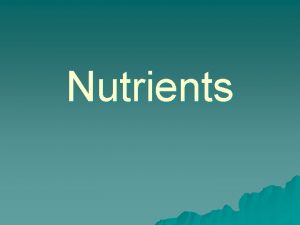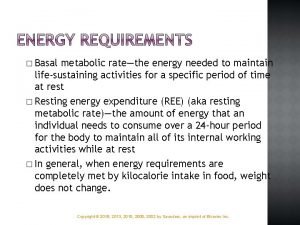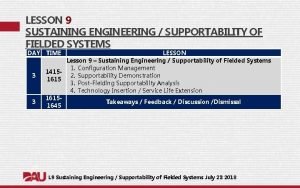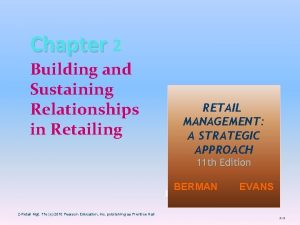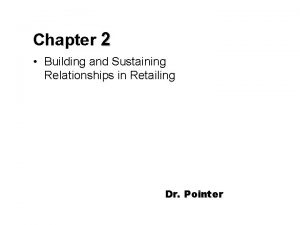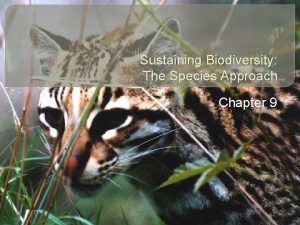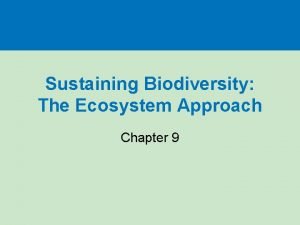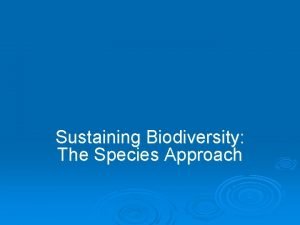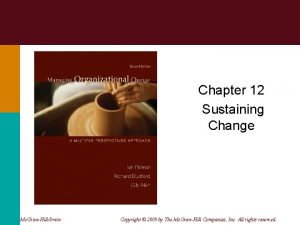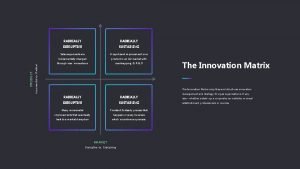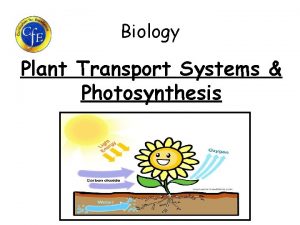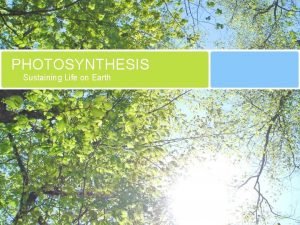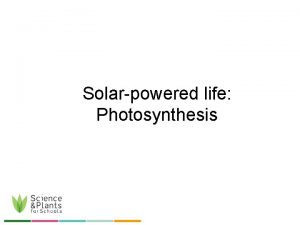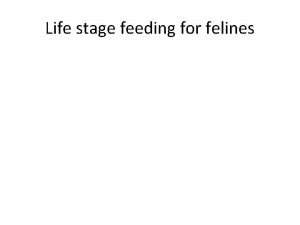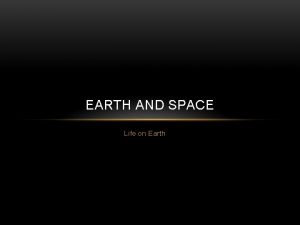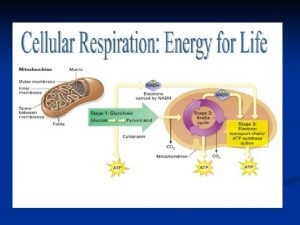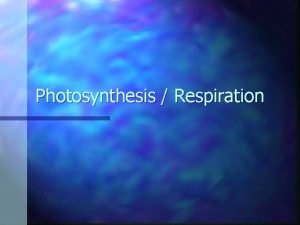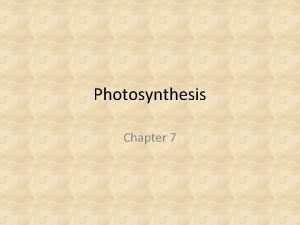PHOTOSYNTHESIS Sustaining Life on Earth Photosynthesis STAGE 1


















- Slides: 18

PHOTOSYNTHESIS Sustaining Life on Earth


Photosynthesis STAGE 1: LIGHT REACTION • In the thylakoid membrane, light energy is captured by pigments which release electrons • Water is broken down, releasing electrons and producing oxygen gas • These free electrons, travel through a series of membrane proteins (electron transport chain) and in the process, ATP and NADPH are produced (reduced form of NADP+) STAGE 2: DARK REACTION (Calvin Cycle) • In the stroma, NADPH, CO 2, and the energy from ATP are used to make glucose All of these stages occur in the chloroplasts of palisade cells.


Photosynthesis Overview

The Light Reaction In this stage, plants use Photosystems I and II to make ATP and NADPH which will be used in the dark reaction to produce glucose. This stage involves a series of steps that all occur in the thylakoid membrane of the chloroplast.

What is a Photosystem? A multisubunit complex found mainly in the thylakoid membranes. It is primarily involved in capturing light to cause a series of redox reactions.


Photosystems I and II

A photon strikes photosystem II and exites one electron of chlorophyll P 680. The electron is passed on to the electron acceptor pheophytin, then to plastoquinone, then through an electron transport chain. Pheophytin is the primary electron acceptor from chlorophyll 680 in photosystem II.

Z protein breaks water into O 2 gas (leaves the cell by diffusion), H+ ions (build up in the thylakoid lumen) and 2 electrons which replace those lost by PSII.

As electrons pass through the Q cycle, H+ ions are transported from the stroma into the thylakoid lumen. 4 H+ ions move in for every 2 electrons passed through the cycle. These electrons are used to replace the electrons lost by PSI.

Excited electrons from photosystem I are passed to ferredoxin, then to the enzyme NADP reductase which helps to reduce NADP+ to NADPH.

H+ that has built up in the thylakoid lumen moves through the ATP synthase protein, and one ATP is made for every 4 H+ that pass through. This is called photophosphorylation

An Overview 1. A photon strikes photosystem II and exites one electron of chlorophyll P 680. The electron is passed on to the electron acceptor pheophytin, then to plastoquinone, then through an electron transport chain. 2. Z protein breaks water into O 2 gas (leaves the cell by diffusion), H+ ions (build up in the thylakoid lumen) and 2 electrons which replace those lost by PSII. 3. As electrons pass through the Q cycle, H+ ions are transported from the stroma into the thylakoid lumen. 4 H+ ions move in for every 2 electrons passed through the cycle. These electrons are used to replace the electrons lost by PSI. 4. Excited electrons from photosystem I are passed to ferredoxin, then to the enzyme NADP reductase which helps to reduce NADP+ to NADPH. 5. H+ that has built up in the thylakoid lumen moves through the ATP synthase protein, and one ATP is made for every 4 H+ that pass through. This is called photophosphorylation.

The Light Reaction

End Result of Light Reaction: • H 2 O is broken down, O 2 gas produced • Proton gradient created by H+ ions is used to create ATP molecules • The electrons make it to the final electron acceptor, NADP+, reducing it to NADPH • ATP and NADPH are only generated when the sun’s light energy is harnessed they both go on to the dark reaction where they are used to create glucose

REFERENCES: • www. unitedstreaming. com • Nelson Biology 12. Thompson Canada Ltd. 2003. Pages 157, 158, 160. • Nelson Biology 12 Student CD. 2003. © 2007. R. Scarth
 The life sustaining substances in foods are
The life sustaining substances in foods are The energy needed to maintain life-sustaining activities
The energy needed to maintain life-sustaining activities Acquipedia
Acquipedia Environmental science sustaining your world
Environmental science sustaining your world Value-oriented retail strategy
Value-oriented retail strategy 3 aspects of value-oriented retail strategy
3 aspects of value-oriented retail strategy Creating and sustaining competitive advantage
Creating and sustaining competitive advantage Sustaining relationships
Sustaining relationships Building commitment meaning
Building commitment meaning Apes chapter 9 sustaining biodiversity
Apes chapter 9 sustaining biodiversity What is the ecosystem approach to sustaining biodiversity
What is the ecosystem approach to sustaining biodiversity Ways to protect the ecosystem
Ways to protect the ecosystem Sustaining expectation effect
Sustaining expectation effect Sustaining change
Sustaining change Sustaining excellence
Sustaining excellence Fugle innovation process model
Fugle innovation process model First stage of photosynthesis
First stage of photosynthesis First stage of photosynthesis
First stage of photosynthesis Stage 1 denial
Stage 1 denial
